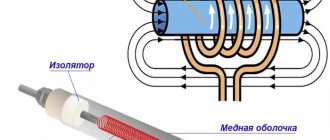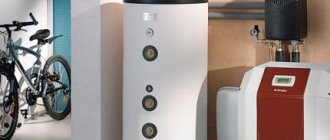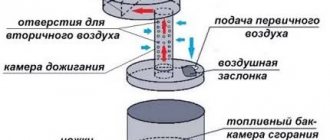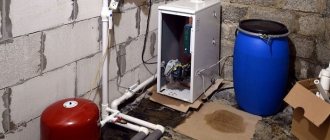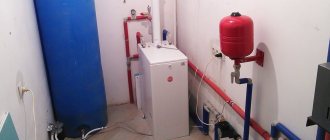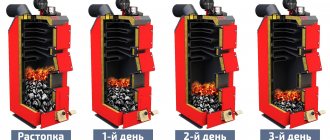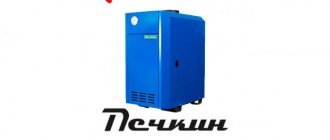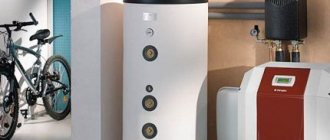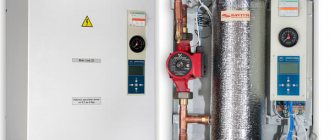Electric boilers are almost ideal in terms of comfort, practicality and reliability; they are easy to set up and require virtually no human intervention during operation. In addition, in addition to the lower initial cost of the boiler, the installation cost is also minimal: the boiler room is not required, there is no need for a chimney, supply and exhaust ventilation, or complex piping.
However, the main disadvantage, which often outweighs all the advantages, is the cost of heating a house with electricity. To heat a house with an area of 100 m2 in winter, you will need up to 13-18 thousand rubles. It is also worth considering that for houses with an area of more than 60-70 m2, a boiler operating from a three-phase (380 V) electrical network will be required, since the power of a standard two-phase (220 V) electrical network will simply not be enough. Electric boilers with a power of over 10 kW require approval from the Energonadzor services.
Heating options
If it is possible to connect to the gas mains, we recommend choosing a gas boiler without hesitation, even despite the complex process of its registration. Otherwise, from an economic point of view, electric heating boilers are not always justified.
Electric boilers are compact in size, require a minimum of wiring and have a modern design, which allows them to be installed anywhere.
The most financially profitable option is to temporarily use an electric boiler. For example, at a dacha or in a second country house, where the owners come only from time to time, but do not live permanently. In such cases, the 1.5-3 times lower initial cost of the boiler, its installation and connection will cover the cost of electricity during operation for a long time.
Since all electric boilers (with the exception of induction) are designed to use exclusively water as a coolant, which freezes at subzero temperatures, it would be desirable in such a situation for the boiler to have the ability to connect external control. For example, using a GSM module or Wi-Fi module. Firstly, this will allow you to control the electric boiler remotely and set the desired temperature before arriving at the house. Secondly, remote control will give you confidence that in the absence of the owners the boiler maintains a positive temperature and the system is not damaged (otherwise you will immediately receive a notification).
Another great option is to use an electric boiler as an additional or backup heating equipment. For example, in a scheme using a buffer tank in case of problems with the operation of the main boiler and heating at a night tariff, or for a heated floor circuit. For such purposes, an inexpensive 3-6 kW electric boiler costing 11-15 thousand rubles, operating from a single-phase power supply, is quite sufficient. It will be able to maintain temperatures above +18°C in a house of about 100 square meters. m. for 2-2.5 days or completely ensure the normal temperature of the heated floor on an ongoing basis.
A simple and compact low-power model EVAN EPO.
Water-heating electric boilers can be used as the main heating equipment only if you have a free budget. The only exceptions are small and insulated houses with an area of up to 90-100 m2. To heat such an area, taking into account medium or dense insulation, an inexpensive electric boiler with a capacity of 6-9 kW will be sufficient. The low cost of the boiler unit and its installation, as well as the absence of the need for its coordination with Energonadzor services, will pay off the high operating costs for another 1-3 heating seasons.
What does an electrode boiler provide?
The very idea of an electrode boiler is this. to refuse the use of heating elements. If you now look at the diagram of an electrode boiler, you will see that electric current passes through the coolant from the electrode, which is supplied with voltage to the body of the boiler, which is also a conductor.
It turns out that instead of a heating element, the heating element here is the coolant itself, which is heated by the movement of negatively charged particles (ions).
Of course, any competent electrician will say that in reality there is no movement there. But for us this is completely unimportant now.
What is important is that losses in this case are minimized. And thanks to this, the electrode boiler has an efficiency of up to 97 percent. Where do these same 3 percent of 100 go, I wrote to you a little higher.
It is important for us that, all other things being equal, an electrode boiler will consume slightly less electricity than a classic boiler with heating elements. This time.
Secondly, the process of heating the coolant itself occurs faster, because when the electrode boiler operates, the entire volume of water is heated at once, and not just the layer next to the surface of the heating element.
But in such a scheme there are not only advantages, but also disadvantages. You will read about them below, in the “Reviews” section.
Reviews of household electric boilers: advantages and disadvantages
| Advantages | Flaws |
| Easy to install and connect. You can install an electric boiler without any special skills; moreover, it does not require a chimney, ventilation system, or boiler room. From the piping - only the supply and return lines (and the DHW circuit in dual-circuit models). | The highest operating costs among all types of boilers. According to operating practice and reviews from owners, even the most energy-saving models and proper use of a room thermostat will not reduce costs to the cost of heating with gas, wood or liquid fuel. |
| Compact sizes. Heating element models have smaller dimensions than gas and liquid fuel wall-mounted counterparts. Compact electric boilers in the form of a flask with a heating element or ionic models barely exceed the diameter of the heating system line. | Models with power over 6 kW require connection to a more powerful three-phase power supply (380 V). Electrical equipment with a power of more than 10 kW requires approval from local Energy Supervision services. |
| Autonomy and convenience. Electric boilers are almost ideal in this regard, since they can work for weeks and months without human intervention. Almost all models have the ability to connect external thermostats. | When using an electric boiler as the main heating equipment, the heating system becomes completely dependent on the power supply. If there are any interruptions, the house may be left without heat. |
| Safety and environmental friendliness. Electric boilers do not produce emissions, there is no open fire, and all models have overheating protection. | Powerful electric boilers create a significant load on the electrical network of the house. Therefore, they require high-quality and serviceable wiring. |
| Low cost of equipment and its installation. | |
| Almost silent operation. | |
| Availability of both single-circuit and double-circuit models. | |
| Low maintenance requirement, simple and reliable device, in which many components have an almost unlimited resource. |
Ways to reduce electric boiler consumption
A thrifty owner will always try to reduce heating costs while maintaining a comfortable temperature in the house. Of course, for this you need to take various heat-protective measures and adjust the boiler equipment.
The most common methods for optimizing the electric heating system of a residential building:
- The most effective option that affects energy consumption is thermal insulation of the walls of the house. Too much thermal energy is wasted in old windows. High-tech PVC windows with multi-layer air chambers significantly reduce the consumption of heat production. The walls of buildings are insulated with effective heat-protective building materials with low thermal conductivity - polystyrene foam, mineral wool and others. It is also necessary to insulate the foundation and roof of the house.
- The transition to paying for electricity using multi-tariff metering is a fairly cost-effective measure. In this case, the boiler unit operates at night during the hours of minimum electricity consumption at the lowest tariff.
- Introduction of automatic electric boiler control devices. Reducing the load on the boiler in standby heating mode when users are not at home.
In order to automate the operation of the boiler, it is possible to use programmable electronic thermostats or boilers with built-in software. Automation adjusts the boiler equipment to a thermal mode that consumes minimal energy consumption. - Installation of a circulation pump to speed up the movement of the coolant. As a result, the heated coolant operates at a low temperature, which will increase the efficiency of the boiler and the service life.
- Use of a weather-compensated control system. Its meaning is that the electrical signal from the primary sensor to change the thermal operating mode of the electric boiler is sent to the heating elements when the outside air temperature changes. Consequently, with an increase in the outside ambient temperature, the boiler reduces thermal output, and, therefore, energy consumption. Therefore, there is no unnecessary generation of thermal energy. Weather-dependent regulation by an electric boiler simultaneously with home thermostats or thermostatic valves makes it possible to achieve a tangible effect on the economical operation of equipment.
- Use of ventilation with recovery. Such a device returns to the house all the thermal energy that was previously lost along with warm room air during the ventilation period. When using such high-power complexes, there is no need to open windows at all for ventilation. With this method of air purification, the humidity and cleanliness of the surrounding air will be maintained at a sanitary level.
In conclusion, it should be noted that electric heating of a house is still a fairly high-cost method, regardless of the specific technology and design of the electric boiler.
It is used exclusively in situations where it is not possible to connect the object to the gas main. However, by installing electric heating correctly, in compliance with norms and standards, equipping the boiler with modern control and protection devices, and also providing good thermal protection of the building, you can ensure that the heating system operates in an efficient mode, while ensuring warmth and comfort in the house.
How to choose an electric boiler for heating a private house
Single-circuit or double-circuit
Single-circuit electric boilers heat the coolant in one circuit - the heating circuit. Double-circuit ones are designed for both heating and hot water supply (DHW). In this case, sanitary water from the DHW circuit does not mix with technical water from the heating circuit.
Double-circuit electric boilers cost only 10-30% more than their single-circuit counterparts and are the most cost-effective way to organize hot water supply at home. However, they are popular only with owners with a relatively unlimited budget, since expensive electricity is also spent on preparing sanitary water.
Single-phase or three-phase power supply
Low-power models up to 6 kW inclusive operate from a standard single-phase network (220-230 V). More and more powerful models require the organization of a three-phase electrical network; this should be taken into account before purchasing an electric boiler. Otherwise, the power of a single-phase network will simply not be enough, the boiler will not be able to provide maximum heating output, the water will take longer to heat up to the set temperature, and in severe frosts the heating output may not be enough at all.
Additionally, information about electrical requirements is always indicated in the technical specifications of the model.
Automation functionality
The most inexpensive models of electric boilers operate on the “On/Off” principle. We recommend choosing electric boilers with at least 3-stage power control, and better yet, with degree-by-degree temperature control. Even greater efficiency can be achieved by electric boilers with a built-in programmer, which allows you to set operating parameters for the next day or week. This way you can set the temperature to 15°C during working hours when the owners are not at home. Also set the temperature to 18-19°C during sleep or, conversely, heat the house more actively at the night electricity tariff if a multi-tariff meter is installed.
However, the built-in programmer is not present in all even expensive models. But almost all modern electric boilers allow you to connect external control, for example, a room thermostat - the most economical and comfortable option of all existing ones. A technologically advanced electronic room thermostat with programmability allows you not only to implement what was described earlier, but also to make more accurate measurements, focusing on the air temperature in the room, and not the temperature of the coolant.
How to choose an external thermostat for an electric boiler and save up to 30% on heating every month
Also in modern models it is possible to support weather control, when the automation adjusts the operation of the boiler to external weather conditions. If the boiler is planned to be installed in a temporary home, frost protection is mandatory to prevent icing and damage to the heating system lines. However, we do not recommend overdoing it with options that are not useful; it is better to find a middle ground. The minimum functionality required for comfort and efficiency is degree-by-degree temperature control, the ability to connect external control or a built-in programmer.
Minimum required power
In practice, the required power is usually calculated in a simplified form, based on the rule: for an average house in the Moscow region with 2 bricks and a ceiling height of up to 2.7 m, 1 kW of heating equipment power is required for every 10 m2 of area. We also recommend setting aside a 15-20% power reserve; for heating electric boilers - up to 30% reserve (more on this later). If the boiler is double-circuit, we recommend adding another 10% power reserve on top.
For example, for a house with an area of 120 m2, the minimum required power of a heating element single-circuit electric boiler is 120/10 * 1.3 = 15.6 = 16 kW.
This method is sufficient in more than 95% of cases. If the house is well insulated, is located in the extreme southern or, conversely, in the extreme northern point of the country, has high ceilings and a large glazing area, it is necessary to make a more accurate calculation taking into account correction factors. You can make a more accurate calculation using the calculator below (for each room separately, then summed up), or better yet, by involving a heating engineer.
User reviews
If you are planning to purchase an electric boiler, it will be useful for you to find out what users say about certain models. This information will help you make the right choice. Therefore, below we will present to your attention real reviews about electric heating boilers received from existing users.
Electric boiler Protherm Skat 6 KR 13
Alexey, 29 years old
I have been installing heating equipment for five years now. During this time, dozens of systems were installed, so we have a lot of experience working with electric boilers. But most of all I liked working with equipment from Protherm. First of all, we should highlight its high quality; there were no complaints from users. And secondly, these electric boilers greatly simplify installation work, as they are equipped with pumps and expansion tanks. It is not surprising that owner reviews of Skat 6 electric heating boilers are positive.
Advantages:
- High level of reliability - electric boilers operate without breakdowns, delighting consumers with warm heating pipes;
- Possibility to be powered from any network - 220V or 380V;
- It is possible to work with heated floors - many people use this.
Flaws:
- They make a little noise when working, but you can’t hear it in other rooms;
- Occasionally there are complaints about leaks.
They cannot highlight any particularly striking shortcomings. Is it the cost, which varies from 27 to 30 thousand rubles.
Electric boiler EVRAZ EVP-6
Ruslan, 42 years old
For a long time I wondered which electric boiler is best for heating a private house with an area of 45 square meters. m. The criteria were as follows: affordable price, extreme simplicity, reliability. As a result, I settled on equipment from EVRAZ. I chose a 6 kW model to have a small reserve. The electric boiler can operate from a single-phase or three-phase network and heat an area of up to 54 square meters. m. During operation, a complete breakdown was detected - one of the heating elements burned out, the repair was carried out under warranty. It heats well and quietly, does not require maintenance. I consider heating with an electric boiler in a private house the best option, since there is no need to bother with diesel fuel or firewood.
Advantages:
- Lowest price - took for 4000 rubles;
- There is nothing superfluous - the fewer additions, the higher the reliability of the equipment;
- Durable steel body;
- A minimum of control elements is an ideal choice for organizing heating in a private home.
Flaws:
- In the first year of operation, the electric boiler broke down - the heating element failed;
- The thermometer and pressure gauge must be purchased separately;
- Clicks when switching heating elements.
This is the cheapest and simplest electric boiler, so no increased demands can be placed on it.
Electric boiler Vaillant eloBLOCK VE 6
Maxim, 33 years old
When I was going to buy an electric boiler to provide heating in my village house, I immediately decided that I would take equipment from well-known brands. The store praised Vaillant, saying it works like a Swiss watch. I listened to the advice, purchased the equipment and began installing the heating. For the first 3-4 months, joy knew no bounds - the house was warm and comfortable. Then problems began, first the heating elements failed, then the circulation pump stalled. After a few more months, the device began to make noise, and the heating was still warm. Contacting the official service did not solve the problem.
Advantages:
- Neat design that captivates the consumer;
- Built-in pump and tank;
- Simple controls;
- Built-in security systems;
- Self-diagnosis;
- Ability to operate in antifreeze mode.
Flaws:
- He has some kind of problem with heating elements, he constantly has problems with them;
- Not the most responsive service;
- I didn’t notice any vaunted efficiency; it consumes a lot, like any other electric boiler - heating operation costs a lot of money, even at rural prices.
It would do well for the manufacturer to refine his brainchild.
Deciding on the type of electric boiler
heating elements new
Construction of a standard heating element electric boiler.
The most common are models in which a heating element (tubular electric heater) or a combination of both – a block of heating elements – is used as a heating element. Models in the form of a flask with a low-power heating element barely exceed the diameter of the heating system line and cost from 3-4 thousand rubles. However, the most popular and successful models are those with a classic rectangular body, which are mini-boiler rooms. Already from the factory, they are usually equipped with all the necessary components of the heating system: an expansion tank, a safety valve, an automatic air vent, a circulation pump, a set of sensors and measuring instruments. It is enough to connect the supply and return lines to the boiler.
It is in heating electric boilers that modern automation is used, which allows you to regulate the temperature by degree, modulating the power of the heating element block. It is also worth paying attention to the possibility of finer settings, the presence of a room thermostat in the kit, the ability to connect external control, and the presence of a built-in programmer.
Perhaps the only significant drawback of heating electric boilers is the formation of scale on the heating elements themselves. This happens when hard, untreated water is used as a coolant. However, even if you do not use filters, water that is not replaced every season will only produce a slight sediment once, with virtually no effect on efficiency. Otherwise, after 3-6 heating seasons, the efficiency may drop to 90, 80 or even 70%. To heat water to the previous temperature through a layer of scale, the boiler will need more power and time.
A layer of scale due to the use of hard coolant.
In extreme cases, the cost of a block of heating elements is in the range of 1,000-3,000 rubles, and you can replace them yourself, without involving specialists. The resource of other components of heating element electric boilers is practically unlimited.
| Photo | Model | Description | price, rub. |
| EVAN EPO-18 | One of the simplest and most inexpensive models is a flask with heating elements. It is controlled by a remote control, of which there are two variations: with 1 power level (on/off) or 3 power levels. Capable of heating the coolant to 85°C, it is equipped only with overheating protection. It is good in terms of price-quality ratio, but is much inferior in functionality to more expensive models (stepped rather than smooth power adjustment, simple operating modes and lack of fine-tuning capabilities). | 14 600-21 000 | |
| Reco 15P | A domestic electric boiler, differing from the previous one by the presence of a circulation pump, a safety valve and an air vent. It has enormous functionality for this price category, a full range of protections and a programmer. However, power adjustment is still stepwise, and the appearance, quality of materials and workmanship are inferior to foreign analogues. Some owners complain about noisy operation. | 24 000-28 000 | |
| Protherm Scat RAY 18 KE /14 | One of the best heating element electric boilers with an expansion tank and circulation pump for heating a private home. Known for reliability and durability thanks to high-quality alloys and assembly. The heat exchanger is additionally thermally insulated, it is possible to connect external controls and heated floors. There is auto-diagnosis, overheating protection, frost prevention mode, safety valve, air vent, pump blocking protection. | 41 000-45 000 | |
| Vaillant eloBLOCK VE 18 | Model of the reference German manufacturer. It is distinguished by highly efficient automation, which allows for more economical energy consumption, high reliability and durability, build quality and modern design. It has an additional layer of thermal insulation and operates almost silently. However, it is advisable to connect through a stabilizer, since the automation is vulnerable to voltage surges. | 48 000-52 000 |
Electrode (ionic)
A visual principle of operation of an electrode heating boiler.
An electrode or a group of electrodes is used as a heating element in ion electric boilers. The principle of operation is to supply them with alternating current, due to which their polarity changes at a high frequency, water ions move to one electrode, then to the other and heat up as a result of friction. Low-power models use only one electrode located in the center, and a metal body is used as the second. More powerful models use blocks of 3 electrodes.
Although the efficiency of all modern electric boilers is 99% or more, electrode electric boilers, when compared with simple heating element models without expensive automation, are considered more economical. After all, scale does not accumulate on the electrodes and they do not lose their effectiveness even after 10 years. On the other hand, ionic models mostly have simple automation with a minimum of adjustments, usually in the form of a remote control. The boilers themselves are just a flask with small diameter electrodes. Despite its compact dimensions, all elements of the heating system such as an expansion tank, circulation pump, safety group, etc. will have to be purchased and installed separately.
Another serious disadvantage of electrode boilers is high grounding requirements, incompatibility with steel and cast iron radiators, and the need to use a special liquid - electrolyte - as a coolant.
Is it worth using electrode boilers for heating a private house?
| Photo | Model | Description | price, rub. |
| Galan Geyser 15 | The most famous, small and reliable ion electric boiler of domestic production. It is equipped with three types of automation: from the simplest to quite advanced with a GSM module. For normal operation, it is advisable to use the coolant recommended by the manufacturer. | 8 200-8 900 | |
| Beryl-15 Ion | The Latvian analogue is known abroad, but underestimated in our country. Automation adjusts the work by assessing the temperature of the coolant and other factors, using energy more economically. | 8 400-8 500 | |
| Galan Galax G352 15 | Designed according to the principle of standard heating element models in a monoblock housing: with a circulation pump, expansion tank, safety valve, air vent. However, for a price comparable to the average price segment of heating element boilers, it is much inferior to them in functionality, of which only three-stage power adjustment and a small display. | 30 000-34 000 |
Induction
Operating principle of induction electric boilers.
Induction water heating electric boilers use an induction coil, which, when voltage is applied to it, creates a magnetic field. A ferromagnetic core (metal pipe) is placed inside the coil, inside which the coolant flows. The magnetic field created by the voltage acts on the core through Foucault eddy currents, heating it. The core, in turn, transfers heat to the coolant. With such flow-through heating, scale does not form, and the coolant heats up 1.5-2 times faster; all boiler components have an almost unlimited resource.
However, the cost of induction boilers is 1.5-2 times higher. All necessary elements of the heating system, as is the case with most electrode boilers, must be purchased and installed separately. The listed advantages are justified only in the industrial sphere; in everyday life they are not significant, especially against the backdrop of the disadvantages and more advanced analogues. Therefore, installing an induction boiler in a private house can only be reasonable if you want to use antifreeze as a coolant. But today, new heating elements models are already beginning to appear, in which antifreeze is allowed.
Are induction electric boilers justified in the heating system of a private home?
| Photo | Model | Description | price, rub. |
| Alternative energy VIN 15 | Electric boiler type VIN (vortex induction heater). It is controlled from a remote control in the form of a small cabinet. The dimensions of the installation of 3 boilers of 15 kW are 720x500x300 mm, and the weight is 75 kg. Floor installation is recommended. | 49 000-55 000 |
Poll: what type of electric boilers did you choose?
Popular models
Next, we will look at the most popular electric boilers for private homes, in demand among buyers. These are models from foreign and domestic manufacturers with good technical characteristics.
Protherm Skat 9 KR 13
We have before us a fairly powerful electric boiler, on the basis of which we can build a heating system in a private house. It operates from two types of networks - single-phase and three-phase. The power of the unit is 9 kW, the efficiency is 99.5%. The boiler is made in a wall-mounted form factor and comes with a built-in piping - there is a circulation pump and a 7-liter expansion tank on board. The maximum pressure in the circuit is up to 3 bar, the coolant temperature ranges from +30 to +85 degrees. Additional features and functions:
- Connection of heated floors - in addition to the main heating;
- Built-in protection systems;
- Self-diagnosis.
If you decide to use an electric boiler in your heating system, feel free to purchase the presented model.
EVAN EPO 2.5
If you need the simplest electric boiler without additional functions and any frills, pay attention to this model.
The device is the simplest electric boiler, made in a flask-shaped body and equipped with a simple heating element. Its power is 2.62 kW, the maximum heated area is up to 25 square meters. m. To control the temperature, it has a simple thermostat. Installation method: floor. There are no additional functions on board. The main advantage of the model is its affordable price, about 5 thousand rubles (may vary within small limits).
EVAN WARMOS-RX 9.45 220
We have before us the best electric boiler according to users. Heating a private house with an electric boiler EVAN WARMOS-RX 9.45 220 will be very simple - the device is equipped with an advanced electronic control system. Its power is 9.45 kilowatts, the heated area is up to 95 square meters. m. To ensure efficiency, increased service life and reduce the load on the electrical network, the unit is equipped with multi-stage power control (5 steps). There is a circulation pump inside. If necessary, external heating control systems are connected to this electric boiler.
Prices: summary table
| Model | power, kWt | Complete set with all elements of CO | price, rub. |
| heating elements new | |||
| EVAN EPO-18 | 18 | No | 14 600-21 000 |
| Reco 15P | 15 | Yes | 24 000-28 000 |
| Protherm Scat RAY 18 KE /14 | 18 | Yes | 41 000-45 000 |
| Vaillant eloBLOCK VE 18 | 18 | Yes | 48 000-52 000 |
| Electrode | |||
| Galan Geyser 15 | 15 | No | 8 200-8 900 |
| Beryl-15 Ion | 15 | No | 8 400-8 500 |
| Galan Galax G352 15 | 15 | Yes | 30 000-34 000 |
| Induction | |||
| Alternative energy VIN 15 | 15 | No | 49 000-55 000 |
BoilersElectric boilers

